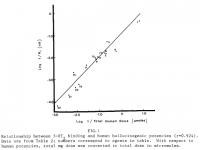Travis
Member
- Joined
- Jul 14, 2016
- Messages
- 3,189
I'm not sure. I did notice that it has strong affinity for one of the histamine receptors.@Travis what do you think of cyproheptadine as a serotonin lowering tool?
I think the best serotonin antagonist would be specific (unless you want to kill two birds with one stone.) I noticed that some also interact with a dopamine receptor.
And it depends on if you want to hallucinate or not. It was shown in 1984 that hallucinogenic potency correlates very strongly with the binding constant to the serotonin receptor #2 (5-HT₂).

A Pearson correlation coefficient of 1 is perfect. This is close at .924.
But this is not the whole story either, because some very strong ligands like bromo-LSD are not very hallucinogenic. Snyder and Merrill showed in 1965 that hallucinogenic activity also correlates well with the highest occupied molecular orbital (HOMO). This is a quantum mechanical value obtained from the Schrödinger Equation and can be understood as its charge-donating potential.
This is different than the redox potential since only one electron, or a fraction (partial transfer), is transferred in a charge-transfer reaction.Thus, despite the crudeness of the theoretical and experimental data discussed here, the close relationship between HOMO energy, an index of electron donation, and the hallucinogenic potency of drugs does favor an electron donation model of drug-receptor interaction. –Snyder
Albert Szent-Györgyi started with this line of reasoning before Snyder had.
It would be interesting to see a 3-dimensional graph of 5-HT₂ binding capability, highest occupied molecular orbital, and hallucinogenic potential on mutually perpendicular coordinates. You might expect that a good fit would be produced.
All of these serotonin inhibitors are probably going to be slightly different based on their HOMO and 5-HT₂ binding affinities as well as their interactions with other receptors. I want to try one of the ergot derivatives simply because they are the "classic" serotonin inhibitors and have been used the most historically.
But I don't want to hallucinate, so I need to consider the highest occupied molecular orbital.
I am sort of partial to bromocriptine, mostly because it has a cool name. This and methysergide are probably the two with the most pharmacologic data on.
Glennon, Richard A., Milt Titeler, and J. D. McKenney. "Evidence for 5-HT2 involvement in the mechanism of action of hallucinogenic agents." Life sciences 35.25 (1984): 2505-2511.
Snyder, Solomon H., and Carl R. Merril. "A relationship between the hallucinogenic activity of drugs and their electronic configuration." Proceedings of the National Academy of Sciences 54.1 (1965): 258-266.
Last edited:
